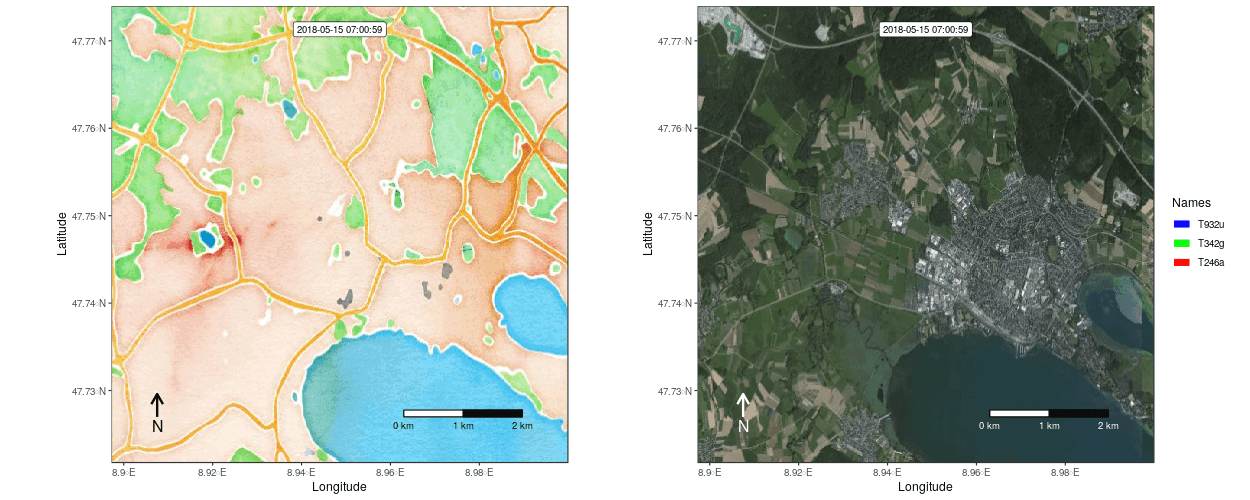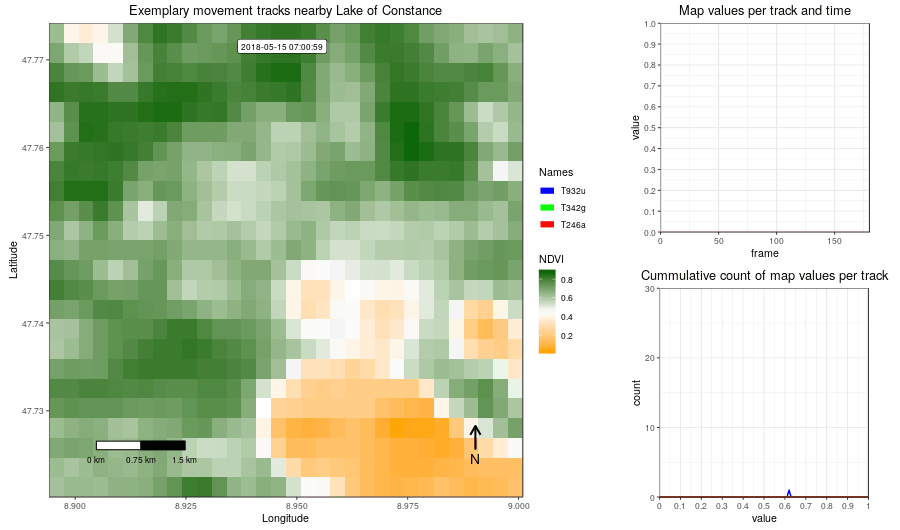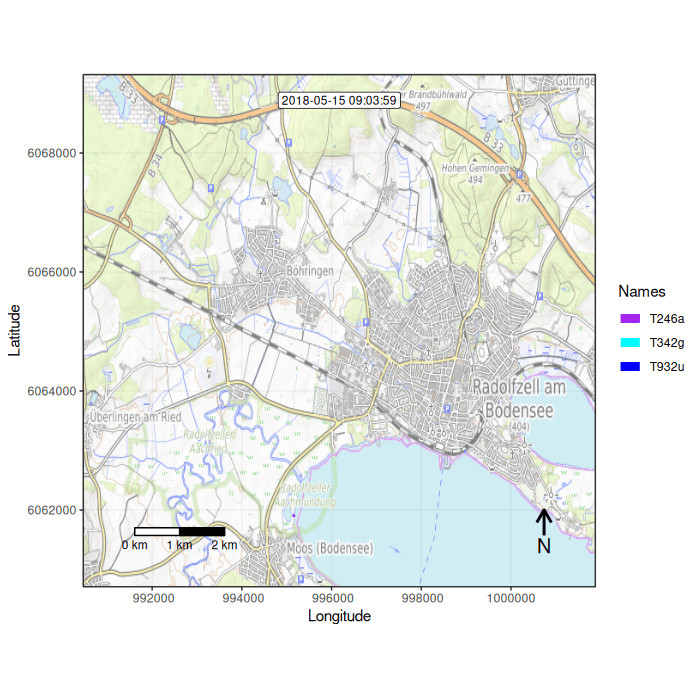

moveVis provides tools
to visualize movement data (e.g. from GPS tracking) and temporal changes
of environmental data (e.g. from remote sensing) by creating video
animations. It works with
move and
raster
class inputs and turns them into
ggplot2
frames that can be further customized.
moveVis uses
gifski
(wrapping the gifski cargo crate) and
av (binding to
FFmpeg) to render frames into
animated GIF or video files.
A peer-reviewed
open-access paper accompanying moveVis has been
published in Methods in Ecology and Evolution.

Figure 1: Example movement tracks nearby Lake of Constance on top of a OSM watercolor and a mapbox satellite base map

Figure 2: Example movement tracks nearby Lake of Constance and a gradient base layer faded over time
With version 0.10.0, the package has been rewritten from the ground up with the goal to make it easier to customize the appearance of movement animations. Thus, the logic of the package, its functions and their syntax have changed.
The latest stable version of
moveVis can be installed
from CRAN:
install.packages("moveVis")The development version can be installed from GitHub:
devtools::install_github("16EAGLE/moveVis")Code written for
moveVis version <=0.9.9
will not work with newer versions, but it is quite simple and thus
highly recommended to switch to the new syntax due to a variety of
advantages. moveVis
version <=0.9.9 can still be downloaded
here
and installed manually:
setwd("your/download/directory")
install.packages("moveVis-0.9.9.tar.gz", repos = NULL)moveVis includes the
following functions, sorted by the order they would be applied to create
an animation from movement and environmental data:
df2move() converts a data.frame into a
move or moveStack object. This is useful if
you do not usually work with the move classes and your
tracks are present as data.frames.align_move() aligns single and multi-individual
movement data to a uniform time scale with a uniform temporal resolution
needed for creating an animation from it. Use this function to prepare
your movement data for animation depending on the temporal resolution
that suits your data.subset_move() subsets a move or
moveStack by a given time span. This is useful if you want
to create a movement animation of only a temporal subset of your data,
e.g. a particular day.get_maptypes() returns a character vector of available
map types that can be used with frames_spatial().
moveVis supports OpenStreetMap and Mapbox basemap imagery.
Alternatively, you can provide custom imagery to
frames_spatial().frames_spatial() creates a list of ggplot2
maps displaying movement. Each object represents a single frame. Each
frame can be viewed or modified individually. The returned list of
frames can be animated using animate_frames().frames_graph() creates a list of ggplot2
graphs displaying movement-environment interaction. Each object
represents a single frame. Each frame can be viewed or modified
individually. The returned list of frames can be animated using
animate_frames().add_gg() adds ggplot2 functions (e.g. to
add layers such as points, polygons, lines, or to change scales etc.) to
the animation frames created with frames_spatial() or
frames_graph(). Instead of creating your own
ggplot2 functions, you can use one of the other
moveVis `add_``functions:add_labels() adds character labels such as title or
axis labels to animation frames created with
frames_spatial() or frames_graph().add_scalebar() adds a scalebar to the animation frames
created with frames_spatial() or
frames_graph().add_northarrow() adds a north arrow to the animation
frames created with frames_spatial() or
frames_graph().add_progress() adds a progress bar to animation frames
created with frames_spatial() or
frames_graph().add_timestamps() adds timestamps to animation frames
created with frames_spatial() or
frames_graph().add_text() adds static or dynamically changing text to
the animation frames created with frames_spatial() or
frames_graph().add_colourscale() adjusts the colour scales of the
animation frames created with frames_spatial() and custom
map imagery using the r_list argument.join_frames() side-by-side joins the
ggplot2 objects of two or more frames lists of equal
lengths into a single list of ggplot2 objects per frame
using cowplot::plot_grid. This is useful if you want to
side-by-side combine spatial frames returned by
frames_spatial() with graph frames returned by
frames_graph().get_frametimes() extracts the timestamps associated
with each frame of a list of frames created using
frames_spatial() or frames_graph() and returns
them as a vector.suggest_formats() returns a selection of suggested file
formats that can be used with out_file of
animate_frames() on your system.animate_frames() creates an animation from a list of
frames computed with frames_spatial(),
frames_graph() or join_frames().view_spatial() displays movement tracks on an
interactive mapview or leaflet map.use_multicore() enables multi-core usage for
computational expensive processing steps.use_disk() enables the usage of disk space for creating
frames, which can prevent memory overload when creating frames for very
large animations.The following example shows how to make a simple animation using a
default base map by first aligning your movement data to a uniform time
scale, creating a list of ggplot2 frames and turning these
frames into an animated GIF:
library(moveVis)
library(move)
data("move_data", package = "moveVis") # move class object
# if your tracks are present as data.frames, see df2move() for conversion
# align move_data to a uniform time scale
m <- align_move(move_data, res = 240, digit = 0, unit = "secs")
# create spatial frames with a OpenStreetMap watercolour map
frames <- frames_spatial(m, path_colours = c("red", "green", "blue"),
map_service = "osm", map_type = "watercolor", alpha = 0.5) %>%
add_labels(x = "Longitude", y = "Latitude") %>% # add some customizations, such as axis labels
add_northarrow() %>%
add_scalebar() %>%
add_timestamps(m, type = "label") %>%
add_progress()
frames[[100]] # preview one of the frames, e.g. the 100th frame
# animate frames
animate_frames(frames, out_file = "moveVis.gif")

You can find code examples on how to use moveVis
here:
Example 1: Creating a simple movement animation
Example 3: Using a mapbox satellite base map
Example 4: View movement tracks
These commented moveVis code snippets, addressing
specific issues or questions, could also be helpful to you:
How to display the full traces of each path using trace_show and trace_colour with frames_spatial()
How to colour paths based on a continuous variable
How to assign multiple path colours per individual, e.g. to indicate behavioral segments
How to adapt the path legend of frames created with frames_spatial()
How to create a data.frame containing each track coordinate per frame
How to overlay frames with additional transparent rasters changing over time (hacky, not a very optimal solution)
Detailed code examples explaining how to use specific functions are provided at the function help pages. User contributions such as code examples or tutorials are very welcome and are linked below as soon as they have been spotted somewhere on the web:
Animating animal tracks from multiple years over a common year with moveVis: An example with Blue Whale Argos tracks on Movebank by Daniel M. Palacios, Marine Mammal Institute, Oregon State University
Reproducible example of how to combine animal tracking data, tidal water height data and a heightmap to visualize animal movement with moveVis by Henk-Jan van der Kolk, The Netherlands Institute of Ecology (NIOO-KNAW)
How to build animated tracking maps using tracking data in Movebank and environmental covariates in track and raster annotations from EnvDATA with moveVis by Sarah C. Davidson, Data Curator at Movebank
Things and features that should be added in future versions of
moveVis (feel free to contribute to this list using a pull
request):
Near future:
Some day:
The Department of Remote Sensing of the University of Würzburg has developed other R packages that might interest you: * getSpatialData, a package to query, preview and download satellite data, * RStoolbox, a package providing a wide range of tools for every-day remote sensing processing needs, * rsMove, a package providing tools to query and analyze movement data using remote sensing.
For other news on the work at at the Department of Remote Sensing of the University of Würzburg, click here.
This initiative is part of the Opt4Environment project and was funded by the German Aerospace Center (DLR) on behalf of the Federal Ministry for Economic Affairs and Energy (BMWi) with the research grant 50 EE 1403.
<a href="https://www.geographie.uni-wuerzburg.de/en/fernerkundung/startseite/"><img width="26%" src="https://www.uni-wuerzburg.de/typo3conf/ext/uw_sitepackage/Resources/Public/Images/uni-wuerzburg-logo.svg"></a>
<a href="http://www.dlr.de/eoc/en/"><img width="17%" src="https://upload.wikimedia.org/wikipedia/commons/thumb/f/f5/DLR_Logo.svg/744px-DLR_Logo.svg.png"></a>
<a href="https://www.bmu.de/en/"><img width="30%" src="https://upload.wikimedia.org/wikipedia/commons/b/b1/Logo_Bundesministerium_f%C3%BCr_Umwelt_Naturschutz_und_nukleare_Sicherheit.png"></a>
<a href="https://www.ab.mpg.de/"><img width="20%" src="https://upload.wikimedia.org/wikipedia/en/c/c9/Max-Planck-Gesellschaft.svg"></a>An open-access
paper accompanying the moveVis R package has been
peer-reviewed by and published in ‘Methods in Ecology and
Evolution’ (see https://doi.org/10.1111/2041-210X.13374). Please
cite moveVis, e.g. when you use it in publications or presentations,
using the output of citation("moveVis") or as follows:
Schwalb-Willmann, J.; Remelgado, R.; Safi, K.; Wegmann, M. (2020). moveVis: Animating movement trajectories in synchronicity with static or temporally dynamic environmental data in R. Methods in Ecology and Evolution. Accepted Author Manuscript. https://doi.org/10.1111/2041-210X.13374